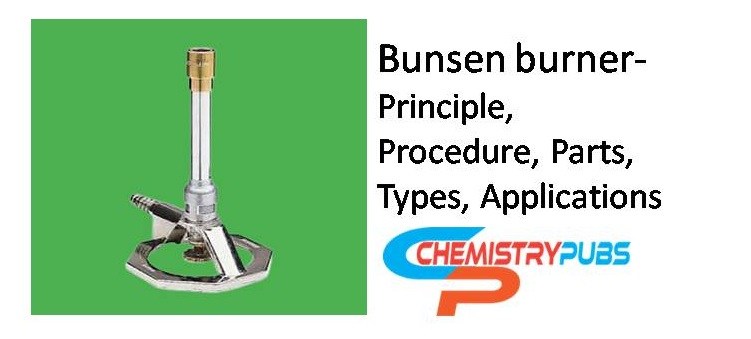Bunsen burner also called a gas burner is used to create a safe, smokeless, hot, and non-luminous flame for various scientific experiments and research. It was invented by Robert Bunsen and his lab assistant Peter Desaga in 1857. It has the ability to produce a single open gas flame that functions in combustion, sterilization, or heating.
It generates luminous and non-luminous flames. The bright flame will change into a non-luminous flame after opening the air hole.
Principle of Bunsen burner in a chemistry lab
It consists of a metal body and a solid base on the bench. A rubber tube helps to connect a lab bench’s gas nozzle to the burner’s primary gas inlet at the burner’s base. It is difficult to come in contact with oxygen and gas to ignite these fuels before they combine with each other. The diameter of the lab gas nozzle is tailored to the type of gas being employed.
There has a few tiny holes in the vertical tube above the path of the gas entrance that allows air to enter the gas mixture from the sides. The gas can be burned at the top of the burner after coming in contact with oxygen. The bottom-mounted adjustable valve has the ability to control the amount of oxygen that is added to the mixture.

It can produce a weaker flame for the shortage of air supply. The combustion level can be identified by viewing the color of the flame. It can be adjusted the air hole or collar to produce flames of various hues. It generates a yellow flame when the air hole is closed completely. It produces a reddish flame upon the air hole being slightly opened. It creates a purple flame when the air hole is just partially opened. A blue flame can arise when the air hole is fully opened.
Parts of the laboratory Bunsen burner
There have various important parts of the Bunsen burner, including:
Stand or base: It helps to support the body of the Bunsen burner that comes in various shapes.
Barrel or chimney: A vertical metal tube about 5 inches long connects with it which comprises an air vent near the bottom formed by oppositely positioned holes.
Collar: It connects the base and the barrel which is a small, cylindrical piece of metal with two holes that are opposite of one another. It controls the air which enters the burner.
Air holes: This part helps to enter the air into the burner to form a mixture of air and gas or any liquid fuel with air.
Gas valve: This part of the burner controls the gas flow.
Gas intake: This part is made by a rubber tube that connects to the gas source at the lab bench.
Fuel sources of a Bunsen burner
Natural gas and liquefied petroleum gas are used as the fuel sources of a Bunsen burner. Each type of burner has a definite type of fuel to use. So it is very important to choose the right choice of fuel source.
There have three types of Bunsen burners, including:
Meeker Fisher burner:
The barrel of this type of burner has a wider diameter than the other types. It has a greater surface area for proper mixing of air and gas for its bigger size. A gas valve which is situated below the chimney or barrel can be used to control the flow of the gas.
Teclu burner
This type of burner generates more heat effectively which has a longer barrel tube compared to other burners. It can be possible to mix air and gas in this type of burner. It can be possible to adjust the gas source by adjusting a screw nut. It has the good ability to increase the flame’s combustion power.
Tirril burner
This type of burner contains a disc valve that can regulate gas flow into the burner.
Operating Procedure of Laboratory Bunsen burner
It should be worn a lab apron and safety glasses for operating this burner carefully. Firstly, it should connect the rubber tube to a gas tap. It can place a heating pad underneath it to operate easily. Then cover for the air hole must be placed on the collar of this burner. Turn the gas faucet in the “on” position. You must put off the match when it is lighter. Then you can able to heat various objects for various purposes.
Uses of Bunsen burner in laboratory
The Bunsen burner is widely used to sterilize loops, needles, and flaming the mouth of test tubes during inoculations. It is very much used for heating purposes, mostly in chemical laboratories. Dehydration of complexes, moisture analysis, drying of salts, and identification of water of crystallization can be done properly by helping this burner. We can use this burner for basic glass-blowing tasks and air drying.
Safety guidelines for using Bunsen burner
It should be controlled at a definite temperature because it can create various accidents during very high-temperature applications, potentially resulting in an accident if not handled mindfully.
It should be inspected daily to check for finding any existence of cracks, holes, or other flaws in the rubber tubing that could lead to a leak. It should be turned off the gas after completing the experiment.

